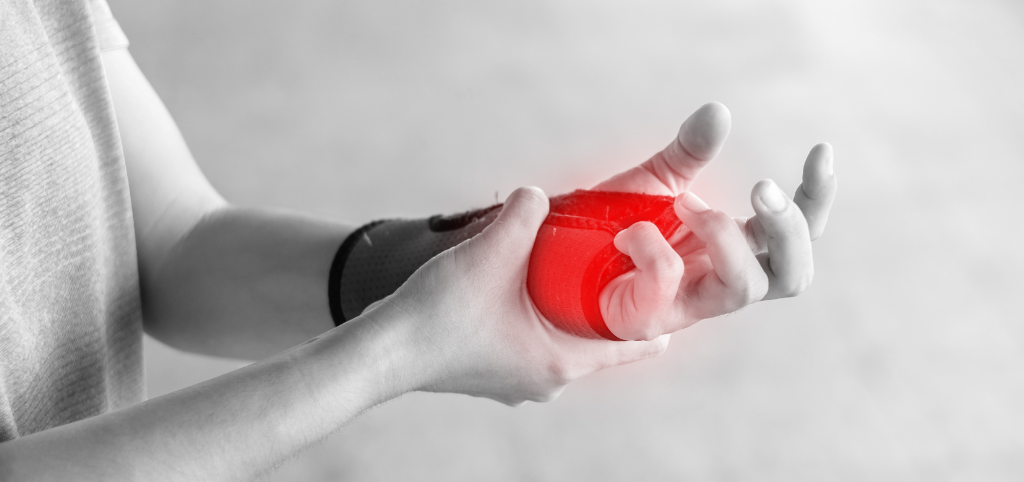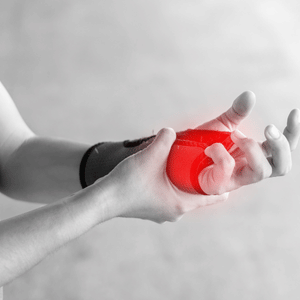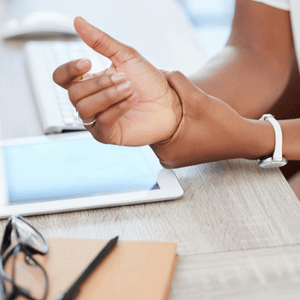Thumb Pain: As chiropractors, we see a wide range of musculoskeletal issues, and one that pops up surprisingly often is De Quervain’s Tenosynovitis. If you’re experiencing pain on the thumb side of your wrist, especially with gripping, pinching, or rotating your wrist, you might be dealing with this condition.
What Exactly is De Quervain’s Tenosynovitis?
Let’s break it down. De Quervain’s Tenosynovitis causes pain in the tendons on the thumb side of your wrist. These tendons, the Abductor Pollicis Longus (APL) and Extensor Pollicis Brevis (EPB), help you move your thumb. When these tendons become irritated and inflamed, the sheath that surrounds them thickens, making movement painful.
Common Symptoms:
- Pain on the thumb side of the wrist, which can radiate up the forearm.
- Swelling in the affected area.
- Tenderness to the touch.
- Difficulty gripping, pinching, or rotating the wrist.
- A “sticking” or “catching” sensation when moving the thumb.
What Causes De Quervain’s?
While the exact cause isn’t always clear, several factors can contribute to its development:
- Repetitive movements: Activities that involve repetitive thumb and wrist motions, like texting, gaming, gardening, or certain occupations (e.g., hairdressing, musicians).
- Overuse: Putting excessive strain on the wrist and thumb.
- Direct injury: A direct blow to the wrist or thumb.
- Hormonal changes: Pregnancy and postpartum hormonal fluctuations can increase the risk.
- Inflammatory conditions: Rheumatoid Arthritis can sometimes be a contributing factor.
How Chiropractic Can Help:
While De Quervain’s tenosynovitis involves tendons, chiropractic care can play a significant role in managing pain and promoting healing. Here’s how:
- Assessment and Diagnosis: We’ll thoroughly assess your wrist and thumb to determine the extent of the condition and rule out other potential causes.
- Joint Mobilization and Adjustments: Gentle adjustments to the wrist and surrounding joints can improve joint mobility and reduce stress on the affected tendons.
- Soft Tissue Therapy: Techniques like massage, trigger point therapy, and instrument-assisted soft tissue mobilization (IASTM) can help release muscle tension, reduce inflammation, and improve blood flow to the area.
- Ergonomic Advice: We can provide guidance on proper posture and ergonomic modifications to your daily activities to minimize strain on your wrist and thumb.
- Stretching and Strengthening Exercises: We’ll prescribe specific exercises to improve flexibility and strength in your wrist and thumb, promoting long-term healing and preventing recurrence.
- Pain Management: We can offer advice on pain management strategies, including the use of ice, heat, and supportive braces.
Beyond the Adjustment:
It’s important to remember that De Quervain’s often requires a multi-faceted approach. In addition to chiropractic care, your chiropractor may recommend:
- Resting the affected hand and avoiding aggravating activities.
- Using a thumb spica splint to immobilize the thumb and wrist.
Don’t Suffer in Silence:
If you’re experiencing thumb pain, don’t ignore it. Early intervention can help prevent the condition from worsening and lead to a quicker recovery. If you suspect you have De Quervain’s Tenosynovitis, schedule a consultation for a personalized treatment plan to alleviate your pain and get back to doing the things you love.
FAQ – Got Thumb Pain -Quervain’s Tenosynovitis
What does De Quervain’s Tenosynovitis feel like and how do I know if I have it?
De Quervain’s typically feels like a sharp or aching pain on the thumb side of your wrist, especially when gripping, pinching, or twisting. You might also experience swelling, tenderness, or a “catching” feeling when moving your thumb. A simple test known as the Finkelstein test—where you bend your thumb into your palm and tilt your wrist downward—can trigger pain and help identify the condition.
Can chiropractors treat De Quervain’s Tenosynovitis effectively?
Yes! Chiropractors can play a crucial role in managing De Quervain’s by addressing joint misalignments, reducing muscle tension, improving tendon function, and relieving pain. At Joint Health Chiropractic Pretoria, Dr. Nerina Le Roux uses techniques like joint mobilization, soft tissue therapy, and custom rehab exercises for long-term relief and prevention.
What causes De Quervain’s Tenosynovitis to flare up?
Common triggers include repetitive thumb or wrist movements (e.g. texting, gaming, or lifting), overuse, direct trauma, and hormonal changes during pregnancy. Poor ergonomics at work or during daily tasks can also contribute to flare-ups.
How long does it take for De Quervain’s Tenosynovitis to heal with treatment?
Healing time varies depending on the severity and how early treatment begins. With chiropractic care, rest, ergonomic changes, and strengthening exercises, many people see improvement in 4 to 6 weeks. Delayed treatment may require a longer recovery.
Do I need surgery for De Quervain’s or can it heal naturally?
Surgery is rarely the first option. Most cases improve with conservative care such as chiropractic treatment, rest, bracing, and rehab exercises. Early diagnosis and a tailored treatment plan significantly reduce the risk of requiring surgical intervention.
Name: Joint Health Chiropractic Pretoria
Address: 501 Jochemus St, Erasmuskloof, Pretoria, 0048
Phone: 0790919756








